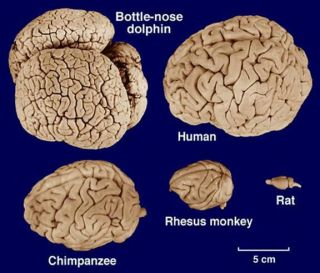Size matters. Thomas Huxley found that mammalian brains are broadly equivalent in structure and differ primarily in size. Even within our own species, there is some evidence that people with larger brains are more intelligent than those with smaller brains, at least as measured by IQ tests. Do humans, then, simply have the largest brains?
Humans have by far the largest brains of all primates, typically weighing between about 1.25 and 1.45 kilograms, and containing some 170 billion cells, about half of which are neurons. The brains of our closest animal relatives, the great apes, weigh about 300 and 450 grams, and the brains of small apes only about 80 grams. Metabolically we heavily invest in brain activity. Our brain comprises about 2 percent of our body mass but consumes some 25 percent of our energy. (Thinking is exercise and costs you 20 to 25 watts to run. Yes, you are exercising right now.) Yet, we do not have the biggest brains on Earth. Elephant brains can weigh over 4 kilograms, and whales have much larger brains still, weighing up to 9 kilograms.

Brain comparisons (by Thomas Retterbush)
This either means these species are in fact a lot smarter than us, or other matters need to be taken into account. The most conspicuous other matter to consider is overall body size. Evidently, elephants and whales do not only have the biggest brains, but also the biggest bodies more generally. So perhaps a fairer way of comparing brains between species is to calculate relative brain sizes. If you take overall body size into account, humans have much larger relative brain sizes than these giant creatures, whose brains comprise less than 1 percent of their bodies.
Yet, in spite of its initial intuitive appeal, it is not entirely clear why relative brain size should matter. Perhaps larger bodies require larger brains in terms of innervations and neural management, but shouldn’t cognitive processing be independent of body size? After all, we don’t become more or less smart when we change relative brain size through losing or gaining weight, do we? Furthermore, some large animals, such as crocodiles, do fine with walnut-sized brains. Why should we adjust brain measures according to body size when large bodies can be run by small brains?
In any case, the outcomes of relative size comparisons have also not been supportive of humans’ sense of superiority. Some shrews and mice, it turns out, have brains that are up to five times larger than ours relative to body size. They can have an extraordinary 10 percent of their body be brain, compared to our 2 percent. This may please fans of Douglas Adams, whose fictional laboratory mice were smarter than us and conducted experiments on human scientists who thought they were experimenting on them, but there are no signs of extraordinary mouse intelligence I am aware of.
Since we get beaten by large mammals in the first scheme and small mammals in the second, a third scheme has been devised that takes into account that as mammals get larger, brains get absolutely larger but relatively smaller. The psychologist Harry Jerison calculated so-called encephalization quotients, or EQs, which compare the actual size of a species’ brain to the size one would expect for an average animal of its size from the same taxon. In this influential scheme, humans emerge on top with a brain over seven times larger than that predicted for the average mammal of our size. Many other animals seem to be ranked in line with common assumptions. Certain findings, however, are unexpected. Some capuchin monkeys, for instance, have surprisingly large EQs that put them well ahead of our closest relatives, the chimpanzees. One may also worry about the influence of the reference group. If instead of comparing us to the average mammal, we narrow this down to a comparison to the average primate, or expand it to a comparison to the average vertebrate, the results change. Not surprisingly, then, debate continues over which measure is most informative.
Concern has been raised about ignoring absolute brain matter altogether in favor of ratios or quotients. Surely there must be something about absolute neuronal resources that enable or limit cognitive capacities. Given limitations of both absolute and relative measures, Andrew Whiten and I combined the two. We took Jerison’s EQs for primates and computed the absolute brain mass that is in excess of that predicted for an average mammal of the same body size. Lo and behold, humans came out on top, with our closest relatives lined up in an order that appears to make intuitive sense. The great apes enjoy absolute neural resources well beyond that typically evident in a mammal of their size, and substantially more than monkeys. Humans have disproportionally more computing power still.
This makes us feel good, perhaps, if a little uneasy. Are we just massaging data to get the results we want? A lot of ink has been spilled on the pros and cons of various measures of brain size comparison, but it remains uncertain whether any of them have unearthed some hidden truth or whether we are simply using statistics to confirm our preconceptions.
The obsession with size may be misleading. When the neurologist Korbinian Brodmann produced his seminal comparative brain maps at the beginning of the twentieth century, Huxley’s claim about structural similarity between mammalian species was confirmed. However, Brodmann appreciated that more sophisticated methods might eventually find differences in internal organization.
New methods are indeed beginning to reveal some subtle differences. For example, new techniques for estimating the number of brain cells in mammals suggest that different scaling rules link brain size and number of neurons for rodents, insectivores, and primates. It turns out that ten grams of monkey brain contain a lot more neurons than ten grams of rat brain. However, these data also suggest that human brains are simply linearly scaled-up primate brains in terms of cell numbers.
Brain characteristics other than cell numbers and overall size may be responsible for our peculiar minds. The human olfactory bulb (the brain area that processes smell) as well as the primary visual area at the back of the brain are relatively smaller in humans than they are in our close relatives. Such changes may reflect some brain reorganization that occurred in human evolution.
Modern neuroscience is beginning to identify finer differences. The first documented microscopic distinction between ape and human brains has been a unique cell organization in a layer of humans’ primary visual cortex—not an area typically associated with higher cognitive functions. There is also some suggestion that humans differ in the neural connections in the prefrontal cortex, an area very much associated with higher cognitive functions. While neurons in the back of the brain have relatively few connections, and human brains differ little from other primates in this respect, there are many connections in the prefrontal cortex. Their density is much higher in humans than in other primates that have been examined thus far. Much more fine-grained counting will be necessary to determine exact quantitative differences.
Future research may well identify characteristics that distinguish various mammalian brains. We are only beginning to unravel the mysteries of brains, so we may hold out for as yet undiscovered features that set human brains critically apart from the rest. As it stands, however, it is not clear what it is about our brains that cause our minds to be special. To find out about the nature of the gap between human and animal minds we therefore need to turn to behavior as an indicator of mind. In this blog I will discuss what psychology has uncovered about what makes us human.
Copyright Thomas Suddendorf
From the book THE GAP: The Science Of What Separates Us From Other Animals




